#Field Columbian Museum
Photo
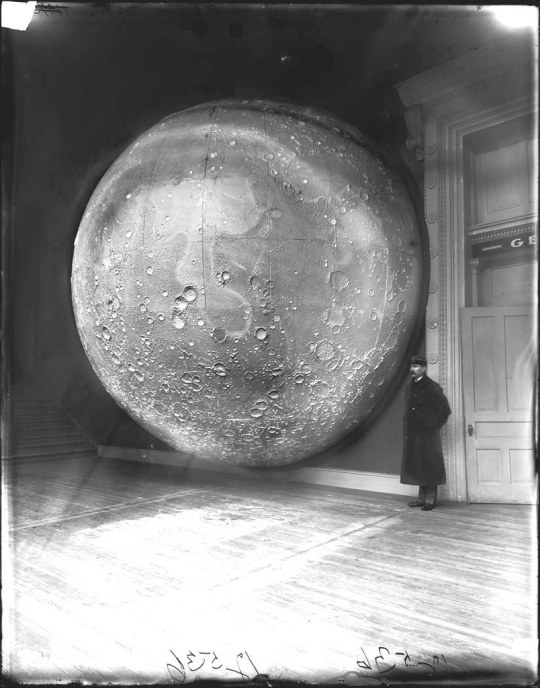
Field Columbian Museum Moon Model, Chicago, Illinois, USA , 1898.
Original caption: Field Columbian Museum West Court Alcove 103. 1898. Moon Model Prepared by Johann Friedrich Julius Schmidt, Germany, in 1898. Made of 116 sections of plaster on a framework of wood and metal. Wood floor, security Guard in uniform in background, stairs leading up to the left. Sign above door,"Geology," not completely visible.
#vintage#retro#museum#museums#1898#1890s#Before 1910#Moon#Astronomy#Geology#Field Columbian Museum#Chicago#USA#United States#Illinois#Natural History#Natural History Museum#Photography#Black and White
41 notes
·
View notes
Text
In my research today I found this textile fragment in the Met Museum's collections:
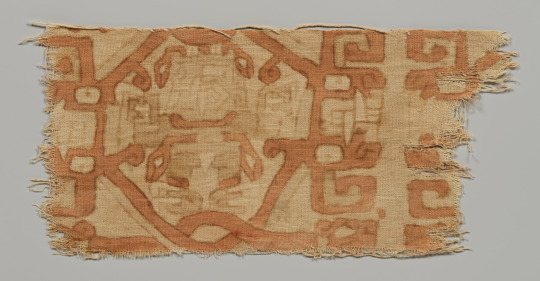
Interesting things about it:
It's coloured with iron earth pigments
It's made of cotton
It's from Peru
From the THIRD OR FOURTH CENTURY BCE
This so shook my expectations of what-where-when that I fell down a rabbit hole and discovered that
Cotton was independently domesticated in the Old World (Asia and Africa) and New World (South and Central America) long before the Columbian Exchange, and
The variety of cotton currently marketed as "Egyptian Cotton" (Gossypium barbadense) is generally grown in Egypt, but it's a cultivar that was developed roughly three thousand years ago in SOUTH AMERICA. Like... Ecuador-region.
(The cotton that originated around Egypt, Gossypium herbaceum, is a perennial shrub that still grows wild, but has largely been replaced by New World varieties for commercial purposes.)
I forget if I posted before about how amazing pre-Columbian lace in South America was? You may not know: I fucking love lace. And that's just part of it. I found a really cool online museum exhibit from Peru that gives a quick overview of how huge the field is.
I found all of this as a side-tangent from cochineal (itself a whole tangent from Slavic folk embroidery), because the world is so enormous and splendid and complicated. Currently debating whether or not to spend an audiobook credit on A Perfect Red by Amy Butler Greenfield.
1K notes
·
View notes
Photo

🐘 The land and sea mammals of Middle America and the West Indies. Chicago: Field Columbian Museum, 1904.
127 notes
·
View notes
Text

Model of the Moon, Field Columbian Museum, Chicago c.1894.
69 notes
·
View notes
Text
At midday on the road into Grünland, a Mennonite colony in the Bolivian department of Beni, the only sound is a distant chainsaw.
On either side, strips of deforested land extend into the distance. Underfoot, the soil is scattered with shards of ceramic and bone: remnants of the pre-Columbian peoples that this part of the Bolivian Amazon, known as the Llanos de Mojos, once supported.
Archaeologists are only just beginning to understand the scale and complexity of these societies, but all the while, the agricultural frontier keeps advancing, destroying sites before they can be studied. The environmental damage of deforestation is well-known, but the Llanos de Mojos reveals another side of its impact: the loss of human history.
Grünland was founded in 2005 by Mennonites, members of the tightly-nit Anabaptist Christian group that began arriving in South America in the early 20th century, in search of isolation and lands to cultivate.
In one field, a Mennonite man called Guillermo was resting in the shade of his tractor. He cheerfully acknowledged finding ceramics and bones while working the land.
Umberto Lombardo, an Italian earth scientist and one of a handful of academics who study the archaeology of Beni, probed gently with questions about the topography of the land when it was first deforested.
The Llanos de Mojos is an almost completely flat region, so any elevated areas are a sure sign of human activity. Lombardo walked about, stopping here and there to pick pieces from the earth of what was once a vast human-made mound, now partly flattened by the farmers.
“The surface of the site is completely destroyed, changed, because the earth has been moved, the pottery broken,” said Lombardo. “That part of the archaeological archive is lost.”
The Mennonites are just one facet of Bolivia’s booming agribusiness, and what is happening in Grünland is happening all over Beni.
The Bolivian government has big plans for the sector. Today, the country has roughly 4m hectares of cultivated land and 10 million cattle. By 2025, the government wants 13m hectares and 18 million cattle.
On the current trajectory the government will undershoot those targets substantially. Nonetheless it has boosted the sector’s growth by allowing more deforestation and reducing fines for illegal deforestation.
In 2021, Global Forest Watch placed Bolivia third in the world for loss of primary forest, behind Brazil and the Democratic Republic of Congo. Ranked by population, Bolivia is first by a distance.
Most of this deforestation is happening in two departments: Santa Cruz and Beni. But it is in Beni that a unique archaeological heritage is at risk.
“Archaeology is everywhere in Beni,” said Lombardo. “They say if you put up a roof, you have a museum.”
The Amazon basin was once considered to be pristine wilderness, but a growing body of research has found traces of a vast network of earthworks predating the arrival of Christopher Columbus in the Americas and implying the existence of large, complex societies.
#Bolivia#deforestation#archeology#pre columbian#beni#mennonites#I feel a bit awkward tagging it with that last one#apologies to the mennonites of tumblr I guess#but look it does have a distinctly doctrine of discovery flavor if you ask me#(I say that making some assumptions as to where Guillermo is from)#there is more active element of#colonization#going on as well#agriculture#ranching
45 notes
·
View notes
Photo

moon sculpture in the field columbian museum
18 notes
·
View notes
Text

Model of the Moon, Field Columbian Museum, Chicago c.1894
3 notes
·
View notes
Text

source: bishopsbox. Thanks to Seth Anderson (Flickr)
Giant olmec head, "El Rey" (The king).
El Rey, Giant olmec head
In November 2008, LLILAS celebrated the arrival of a special work of art on campus. The Universidad Veracruzana, one of Mexico’s most prominent universities, presented the institute with a colossal Olmec head, a replica of the iconic sculpture known as San Lorenzo Monument 1, or El Rey.The original, now housed in the Museo de Antropología in Xalapa, Veracruz, is considered a signature piece of pre-Columbian Olmec culture and a world-class art object that represents New World civilization as emblematically as the Pyramid of the Sun at Teotihuacán or the ruins of Machu Picchu. One of seventeen colossal heads still in existence, San Lorenzo Monument 1 was found by noted archaeologist Matthew Stirling in the 1940s. His discoveries, and those of other archaeologists in Mexico during this time, unearthed for the world the culture of the Olmec, an ancient civilization that flourished in southern Mexico 1500-400 BCE and significantly influenced later cultures such as the Maya and Aztec.The replica that now sits at the entry to LLILAS and the Benson Latin American Collection is made of solid stone and weighs 36,000 pounds. It was sculpted by Ignacio Pérez Solano, a Xalapa-based artist, who has spent his career exploring the history of the Gulf Coast and Mesoamerica. Pérez Solano meticulously reproduced San Lorenzo Monument 1 inch by inch, recreating the powerful lines and imposing features of the original work.Pérez Solano began creating replicas of Olmec heads under the initiative of Miguel Alemán Velasco, who as governor of Veracruz from 1998 to 2004 endeavored to make Olmec culture better known beyond the borders of Mexico. Reproductions of other colossal heads can be found at the Smithsonian Institution in Washington, D.C., and the Field Museum in Chicago, among other locations. Miguel Alemán Velasco was present for the dedication ceremony at LLILAS on November 19, 2008, which also featured remarks by UT President William Powers and his counterpart, Raul Arias Lovillo of the Universidad Veracruzana. Fidel Herrera Beltrán, current Governor of Veracruz, also spoke, as did Olmec scholars from the U.S. and Mexico.
5 notes
·
View notes
Text
10 Reasons Why People Love Lakeland FL

Lakeland, Florida isn't your average Sunshine State city. Sure, it boasts warm weather year-round and access to stunning beaches, but this charming metropolis nestled between Tampa and Orlando offers a unique blend of urban vibrance, outdoor recreation, and historic appeal. Here's why Lakeland might just be your perfect Florida paradise:
Lake Life Paradise: Where else can you say you live amongst 38 glistening lakes? Lakeland's crown jewel, Lake Mirror, offers a scenic walking path, the picturesque Hollis Garden, and even resident swans! Boating, fishing, and kayaking are just a few ways to commune with nature on these freshwater gems.
Thriving Downtown Charm: Lakeland's historic downtown is a delight to explore. Munn Park, lined with early 1900s architecture and antique shops, transports you to a bygone era. The Saturday Farmers Market bursts with local produce, artisanal crafts, and the sweet sounds of street performers.
Cultural Gem: Don't be fooled by Lakeland's laid-back vibe. The Polk Museum of Art boasts an impressive collection spanning pre-Columbian artifacts to contemporary masterpieces. Florida Southern College, a Frank Lloyd Wright architectural wonder, offers stunning tours and a glimpse into the famed architect's vision.
Outdoor Adventure Awaits: Calling all nature enthusiasts! Lakeland caters to your adventurous spirit. Hike or bike the scenic trails at Colt Creek State Park, or challenge yourself at the thrilling Carter Mountain bike trails. Adrenaline junkies can test their skills at Elite Cable Park, a haven for wakeboarding and watersports.
Family-Friendly Fun: Lakeland is a haven for families. Lakeland Explorations Children's Museum provides hours of interactive learning fun, while Explorations VKB National Wildlife Refuge allows for close encounters with alligators and native birds. Splash pads, parks, and a vibrant community calendar of events ensure there's never a dull moment.
Foodie Paradise: Lakeland's culinary scene is booming! From fresh seafood at local spots to trendy gastropubs and international flavors, your taste buds will thank you. Don't miss the chance to savor a juicy steak at a historic Lakeland eatery or grab a gourmet coffee and pastry at a charming downtown cafe.
Affordable Sunshine: Compared to its flashy cousins on the coast, Lakeland offers a haven of affordability. Housing costs remain reasonable, allowing you to live comfortably and enjoy the Florida lifestyle without breaking the bank.
Sports Fanatic's Dream: Cheer on the Detroit Tigers at their spring training home, Publix Field at Joker Marchant Stadium. Catch a thrilling game and soak up the electric atmosphere – a must-do for any baseball aficionado.
Convenient Location: Lakeland's central Florida location is ideal. A short drive puts you on the world-famous beaches of the Gulf Coast or amidst the theme park thrills of Orlando. Enjoy the best of both worlds: relaxation and excitement are always within reach.
Small-Town Community, Big-City Amenities: Lakeland offers a unique sense of community. Friendly faces, local events, and a strong sense of civic pride create a welcoming atmosphere. Yet, you'll also find all the conveniences of a larger city, from top-rated hospitals to excellent schools.
Lakeland, Florida, is a city that truly offers something for everyone. Whether you crave outdoor adventures, cultural immersion, or a family-friendly atmosphere, Lakeland promises a lifestyle steeped in sunshine, charm, and endless possibilities. Come discover why Lakeland might just be your perfect place to call home.

Taking care of your trees is crucial for maintaining a healthy landscape and a beautiful property. But when it comes time to hire a tree service company in Lakeland, FL, you want to make sure you choose a professional, qualified arborist. Here are some key things to consider:
Qualifications: Look for a company with licensed and insured arborists on staff. ISA Certification demonstrates a commitment to professional tree care practices.
Experience: Ask about the company's experience with your specific needs – tree removal, trimming, pruning, or storm damage restoration.
Safety: Inquire about their safety record and observe their practices during consultations.
Communication: Ensure clear communication throughout the process, from initial estimates to project completion.
Reputation: Read online reviews and ask for referrals to get a sense of the company's customer service.
By following these tips, you can find a reputable Lakeland tree service company that will provide exceptional care for your trees. Lyons Family Tree Care is committed to these values and would be happy to discuss your tree care needs. Contact us today for a free consultation!
Lyons Family Tree Care
8819 Park-Byrd Rd, Lakeland FL 33810
(863) 262–7979
https://lyonsfamilytreecare.com/
0 notes
Text
There is something new in the past: the state of the art of archaeological research in the Amazon – Eduardo Neves
Conference: The President of FAPESP, Marco Antonio Zago, invites Eduardo Neves, director of the Museum of Archeology and Ethnology of the University of São Paulo (MAE-USP) to the conference March 22, 2024 - from 10am to 11:30am
Amazonian archeology has changed a lot in the last twenty years. At the end of the 1990s the main topic of discussion was whether the Amazon was densely populated in the past. Today it is accepted that the ancient occupations of indigenous peoples played an important role in the transformation of nature over the millennia and in the formation of the Amazon as we know it.
It is currently established that the Amazon was an independent center of plant domestication and cultivation, in the same way that research carried out in Bolivia, Brazil and Ecuador provides evidence of urbanism on a scale that still needs to be better understood. However, as archaeological knowledge has grown exponentially, so have the threats facing the Amazon and its people. In Brazil alone, almost 20% of forest cover has been lost in the last 40 years. The conference will review the results of recent studies and present the initiatives of the Brazilian archaeological community to face these threats.
Eduardo Neves is a renowned Brazilian archaeologist, known for his significant contributions to the field of pre-Columbian archaeology, especially in the Amazon region. He is internationally recognized for his pioneering work and innovative approach to understanding the history and culture of ancient Amazonian societies.
Neves is a professor at the Museum of Archeology and Ethnology at the University of São Paulo (MAE-USP) and has a long history of research in the area. His studies focus on topics such as the emergence of complex societies in the pre-Columbian Amazon, the relationship between human occupation and the natural environment, and cultural and commercial interactions between different indigenous groups in the region.
Throughout his career, Eduardo Neves carried out excavations at several archaeological sites in the Amazon, making important discoveries that have contributed to a more complete understanding of the region's ancient history. He is also the author of numerous academic articles and books, in which he shares his research and analyzes on Amazonian archeology.
In addition to his fieldwork and research, Neves also plays an active role in training new archaeologists, mentoring postgraduate students and promoting the development of archeology in Brazil.
In the context of Brazilian and Latin American archaeology, Eduardo Neves is a prominent and respected figure, whose work continues to influence and inspire future generations of researchers in the field.
#edisonmariotti @edisonblog
edison mariotti
.br
Há algo de novo no passado: o estado da arte da pesquisa arqueológica na Amazônia – Eduardo Neves
Conferência: O Presidente da FAPESP, Marco Antonio Zago, convida para a conferência de Eduardo Neves, diretor do Museu de Arqueologia e Etnologia da Universidade de S~]ap Paulo ( MAE-USP) 22 Março de 2024 - das 10h às 11h:30
A arqueologia amazônica mudou muito nos últimos vinte anos. Ao final da década de 1990 o principal tema de discussão era se a Amazônia era densamente povoada no passado. Hoje é aceito que as ocupações antigas dos povos indígenas tiveram um papel importante na transformação da natureza ao longo dos milênios e na formação da Amazônia que conhecemos.
Atualmente está estabelecido que a Amazônia foi um centro independente de domesticação e cultivo de plantas, da mesma forma que pesquisas feitas na Bolívia, no Brasil e no Equador trazem evidências de urbanismo em uma escala que ainda precisa ser melhor compreendida. No entanto, à medida que o conhecimento arqueológico cresceu exponencialmente, também cresceram as ameaças que a Amazônia e seus povos enfrentam. Só no Brasil, quase 20% da cobertura florestal foi perdida nos últimos 40 anos. A conferência trará um balanço de resultados de estudos recentes e apresentará as iniciativas da comunidade arqueológica brasileira para fazer frente a essas ameaças.
Eduardo Neves é um renomado arqueólogo brasileiro, conhecido por suas contribuições significativas para o campo da arqueologia pré-colombiana, especialmente na região amazônica. Ele é reconhecido internacionalmente por seu trabalho pioneiro e sua abordagem inovadora para entender a história e a cultura das sociedades antigas da Amazônia.
Neves é professor titular do Museu de Arqueologia e Etnologia da Universidade de São Paulo (MAE-USP) e tem uma longa trajetória de pesquisa na área. Seus estudos têm foco em temas como o surgimento de sociedades complexas na Amazônia pré-colombiana, a relação entre a ocupação humana e o ambiente natural, e as interações culturais e comerciais entre diferentes grupos indígenas na região.
Ao longo de sua carreira, Eduardo Neves realizou escavações em diversos sítios arqueológicos na Amazônia, fazendo descobertas importantes que têm contribuído para uma compreensão mais completa da história antiga da região. Ele também é autor de numerosos artigos e livros acadêmicos, nos quais compartilha suas pesquisas e análises sobre a arqueologia amazônica.
Além de seu trabalho de campo e pesquisa, Neves também desempenha um papel ativo na formação de novos arqueólogos, orientando estudantes de pós-graduação e promovendo o desenvolvimento da arqueologia no Brasil.
No contexto da arqueologia brasileira e latino-americana, Eduardo Neves é uma figura proeminente e respeitada, cujo trabalho continua a influenciar e inspirar gerações futuras de pesquisadores na área.
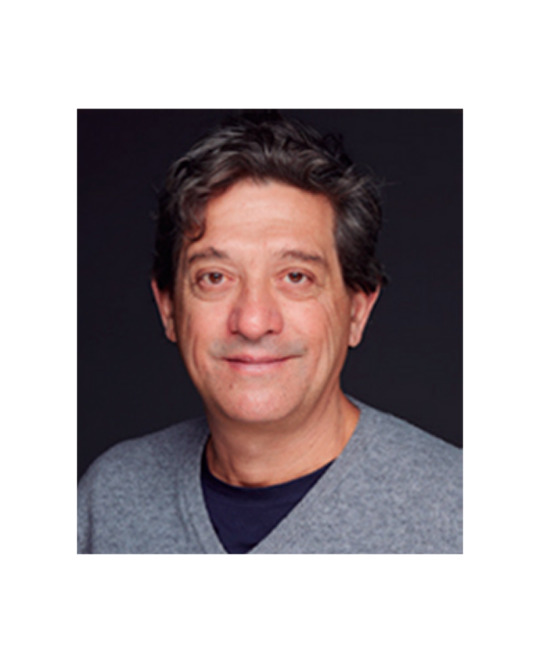
0 notes
Photo
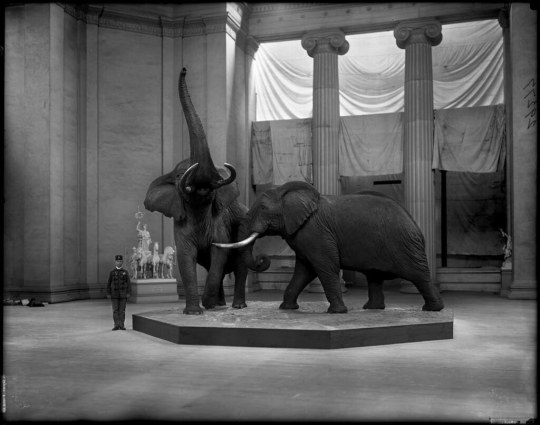
African Elephant Group and security guard, Field Columbian Museum, Chicago, Illinois, USA, 1909.
Original caption: African Elephant Group (Loxodonta africana, Proboscidea Elephantidae) and security guard. Taxidermy by Carl Akeley. Background shows the columns that have been draped with large white sheets. White plaster miniature sculpture models of 2 figures and horses from Agriculture Building of World's Columbian Exposition.
#Vintage#Retro#Museum#Museums#Natural History Museum#Natural History#African Elephant#Elephant#Field Columbiam Museum#Chicago#USA#1909#Before 1910#Illinois
75 notes
·
View notes
Text

1898 photograph of Thomas Dickert and Johann Friedrich Julius Schmidt’s model moon, which was constructed of 116 sections of plaster on a framework of wood and metal. Location: Chicago’s Field Columbian Museum.
0 notes
Text
Tequila and Guachimontones
One last road trip from Ajijic. We went to the unique precolumbian ruins of Guachimontones and then on to the town of Tequila.
Guachimontones is over 2,000 years old and was built by the Teuchitlán people. Not much is known about the Teuchitlán people other than what they can see in the ruins and extrapolate from evidence in surrounding peoples.
What makes Guachimontones special is the circular ceremonial centers. There is a circle of square platforms that would have held temples surrounding an open space with circular "pyramid' in the center. Guachimontones has at least 10 of these units of varying sizes. Here are aerials of the site before and after excavations.


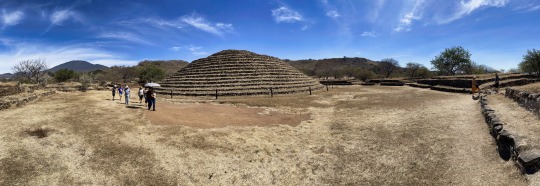

Speculation is that they did ceremonial circle dances. Small ceramic statuary from other places has people dancing like this. So maybe these people took it to the next level. Of course we will never know.
There is a small museum with a little bit of artifacts, but interestingly a lot of modern interpretation of the society that was humorous. This large recreation of a group circle dancing to music has the musicians using a drum machine, laptop, piano, and other modern instruments.

The ruins are on a hill high above a pretty lush valley, which seems to be a common place for pre-columbian ceremonial sites.

Then we drove to Tequila. We couldn't get into any distillery tours because we didn't have a reservation, although the web sites didn't mention the need for one. So we walked around town a bit. We watched a demonstration of the guys flying around a pole as they spun down. I wondered what it would be like to vomit all the way down while hanging from my heels. It doesn't seem like a good idea.
I tried to find a bar that would specialize in tequila flights of tastings of several kinds or just a liquor store with an especially good selection. But we failed at this also. By then it was time to start heading back. A lot of the trip back was, thankfully, on a toll road that was in good shape and not speed bumps, but we had plenty of those for the day. I let Rob drive back which meant I could actually take a photo of the fields of blue agave.

0 notes
Text
Fwd: Postdoc: FieldMuseum_Chicago.InsectPhylogenomics
Begin forwarded message:
> From: [email protected]
> Subject: Postdoc: FieldMuseum_Chicago.InsectPhylogenomics
> Date: 15 December 2022 at 07:19:51 GMT
> To: [email protected]
>
>
>
> The Field Museum is a not-for-profit organization located on the Museum
> Campus of Chicago. Since the 1893 World's Columbian Exposition, we
> have conducted research across all seven continents and accumulated a
> collection of over 40 million specimens and artifacts.
>
> The Field Museum is searching for a Postdoctoral Researcher to join
> our team!
>
> The Postdoctoral Researcher will report to our Assistant Curator of
> Pollinating Insects in Life Sciences, Negaunee Integrative Research
> Center, Bruno de Medeiros. The Postdoctoral Researcher will work closely
> with de Medeiros, focusing on work on systematics and diversification of
> flower-associated beetles and other insects, including projects involving
> specimen-based research, pollen metabarcoding, phylogenomics, fieldwork,
> mentoring volunteers and undergrads.
>
> Duties and Responsibilities:
>
> Generate and analyze phylogenetic datasets for flower-associated insects
> Contribute to fieldwork internationally or locally Mentor undergrads,
> interns, and volunteers Disseminate scientific results in the form of
> outreach, presentations, or publications
>
> Qualifications:
>
> A Ph.D. in Evolutionary Biology or related fields by the start date
> Experience in generating and analyzing high-throughput sequencing data
> for the purposes of studying insect phylogenetics and diversification
> Experience in working with specimens from collections Ability to work
> in groups and supervise undergrads, interns, and volunteers Written
> and oral skills for publication and presentation of research results
> Experience with Neotropical fieldwork is desirable but not necessary
>
> Complete applications include a cover
> letter, CV and contacts for 2 references uploaded
> athttps://careers.hireology.com/fieldmuseum/1017870/description
> Review of applications will start on January 2, please contact
> [email protected] for any questions.
>
> Best,
>
> Bruno
>
>
> Bruno A. S. de Medeiros
> Negaunee Assistant Curator of Pollinating Insects
> He/him/his
>
> Field Museum
> 1400 S. DuSable Lake ShoreDr.
> Chicago, IL 60605
> fieldmuseum.org
>
>
>
> Bruno de Medeiros
0 notes
Text

Model of the moon exhibited at the Field Columbian Museum, Chicago, Illinois, USA, made by Johann Friedrich and Julius Schmidt, 1898
0 notes
